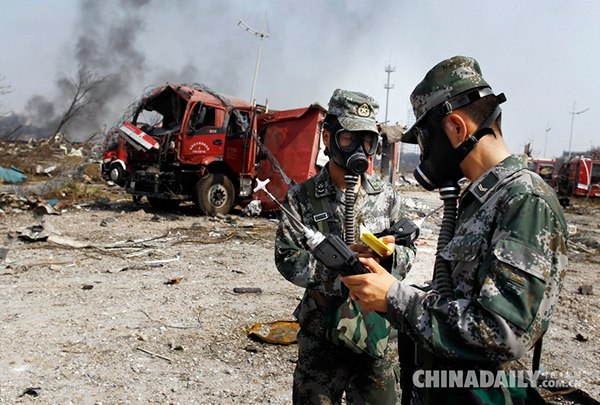Sodium cyanide cannot turn into toxic rain
(chinadaily.com.cn) Updated: 2015-08-19 17:25
 |
|
Air quality is monitored amid suspicions that the warehouse stored dangerous chemicals. [Photo by Zhu Xingxin/chinadaily.com.cn] |
Should people in Tianjin worry about sodium cyanide turning into toxic rain? How dangerous is this chemical? What should be done if somebody comes in contact with it? To answer these and other questions, Qu Ruijing, a senior chemical researcher, and some selected Internet users took part in a Q&A session with Xinhua on Monday.
Here are the excerpts:
Q1: Sodium cyanide is found in how many forms?
It can be liquid or solid. It exists in solid phase as it's easy to pack and is economic.
Q2: Can an explosion change the form of the sodium cyanide?
No, the blast wave will only break the package, not turn sodium cyanide into liquid. Some of the sodium cyanide can disperse after the blast and its size may shrink.
Q3: When does it turn dangerous for humans?
It turns dangerous when it encounters enough water. Sodium cyanide will react with water to produce highly toxic gas, such as hydrogen cyanide. One kilogram of water will dissolve 0.4 kg solid sodium cyanide.
Q4: What is the reaction on humans when hydrogen cyanide mixes with air?
There won't be any reaction if people do not come in contact with the gas. For now, the level of sodium cyanide is only slightly above the normal. It can make some people cough.
Q5: Can sodium cyanide turn volatile in air?
No, unless the package is broken and comes into contact with enough water.
Q6: Why has the level of sodium cyanide exceeded the normal level and what measures should be taken to minimize the risks?
A small amount of sodium cyanide may have come in contact with water when firefighters tried to put out the blaze. Now professionals will expand their testing areas to contaminated soil to make sure nothing is left untested. Spraying hydrogen peroxide on areas contaminated by sodium cyanide will be the next move as hydrogen peroxide neutralizes sodium cyanide.
Q7: Is sodium cyanide airborne?
Its spreading in air is almost impossible. The possibility of it spreading on massive scale is low.
Q8: Can sodium cyanide go with airflow and contaminate the rain cloud?
Sodium cyanide is a white, water-soluble solid. When it mixes with water even at low temperature, it forms the toxic gas hydrogen cyanide.
But it cannot turn into toxic rain because it is easily oxidized even before rain falls. In addition, the blasts site is rich in oxygen and full of carbon particles.
Under such circumstances, it is easy for hydrogen cyanide to turn into ammonium formate. Usually such reactions become more common when the temperature increases, especially when the temperature is above 60 degrees Celsius.
Q9: What should people do?
The only thing people should do is keep away from sodium cyanide.
Contaminated areas should be quarantined as well as people should avoid entering the blast site. Downstream danger extends to 1.3 km during daytime and 4.9 km at night.
If somebody comes in contact with the substance, they should take off the contaminated clothing and rinse the skin with flowing water or add five percent of sodium thiosulfate to liquid and clean themselves, then seek medical help.
Q10: What is the best way to transport and store sodium cyanide?
It should be transported and stored in a leakproof container, avoid high temperature, high pressure and contact with liquid.
More questions about sodium cyanide please click here
- Delegation salutes Tibet anniversary
- Officials are told to act as anti-graft watchdogs
- Great Wall safeguarded in united action
- Vice minister pledges more efforts to improve air quality
- Beijing’s efforts to control air pollution start to pay off
- China's military committed to reform
- Netizens rip singer over baby photos
- Central govt's growing support for Tibet
- Monument to be built on Tianjin blast site
- China and Russia seal raft of energy deals







